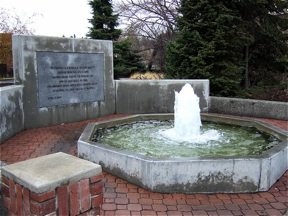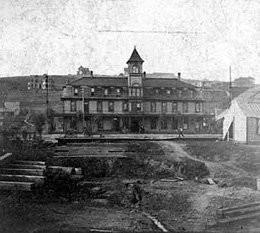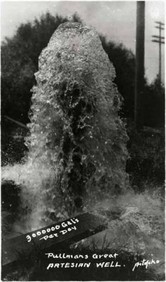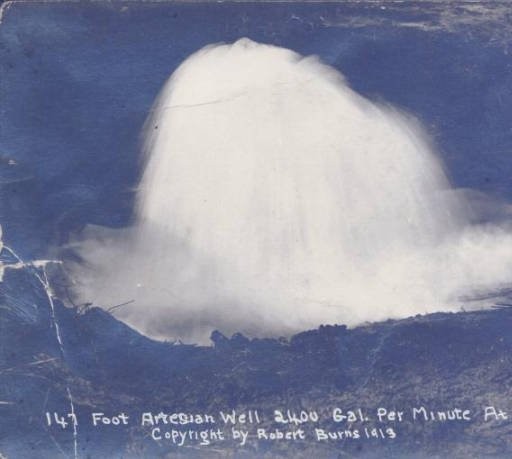Artesian Well
Introduction
Text-to-speech Audio
Images
The fountain in downtown Pullman

The Palace Hotel, near where the first artesian well in Pullman was discovered

Ca. 1890 photograph of Pullman’s great artesian well, taken by Artopho Studio. Courtesy WSU Special Collections. http://content.libraries.wsu.edu/cdm/singleitem/collection/pullman/id/1841/rec/1

1913 photograph of the artesian well taken by Robert Burns. Courtesy WSU Special Collections. http://content.libraries.wsu.edu/cdm/singleitem/collection/pullman/id/650/rec/1

Backstory and Context
Text-to-speech Audio
Pullman was a thriving town in the late 1800s. The area was already a prosperous grain-producing region, but the arrival of railroads in the 1880s led to a flurry of new businesses and residents in the city. Among those new businesses was the Palace Hotel, which opened in 1889. While contractors were digging a well for the new hotel, they struck figurative gold when they discovered an underground aquifer. In an area in which agriculture was the backbone of the economy, this was a fortuitous find, and as many as twenty artesian wells were soon dug in the city.
Hand pumps were constructed throughout the city to propel the water to the surface. A city pumping station and hose cart building were located at the corner of Kamiaken and Olsen by January 1891 and they utilized a Holly system to pump the water into a reservoir with a 150,000-gallon capacity.1 Four- and six-inch water pipes extended from the pumping station to provide water to the growing community.
The discovery would prove to be beneficial in an unexpected way as well. In 1890, just a few months after gaining statehood, the Washington legislature announced plans for the creation of a land-grant college, Washington State College. There was a lengthy search for a location, with several towns lobbying to be chosen. Pullman advertised its artesian wells as one of its principal assets. The legislature chose Pullman and locals have long believed it was largely because of its ready supply of water.2 The college opened in 1892 and helped to secure Pullman’s continued growth.
It is believed that the artesian wells secured another economic benefit for the city. The Northern Pacific Railroad was considering rerouting the line through Whelan, which would have dealt a serious blow to Pullman’s economy. The discovery of an abundant water supply supposedly persuaded railroad officials to remain in Pullman. Civic boosters worked overtime to promote the freight advantages of keeping the rail line running through Pullman.3
The city relied upon these wells for several decades, until depleted groundwater made them obsolete by the 1970s. This fountain is a modern representation of Pullman’s former legacy as “The Artesian City."
Sources
2. "Pullman’s New Artesian Well Would Serve 80,000 People," The Pullman Herald, October 31, 1913: 1.
3. Judge Thomas Neil, Incidents in the Early History of Pullman and the State College of Washington (Fairfield, WA: Ye Galleon Press, 1977), 7.
